Arcam's 2022 AVR line-up: everything you need to know
We compare all the specs of Arcam's latest home cinema amplifiers
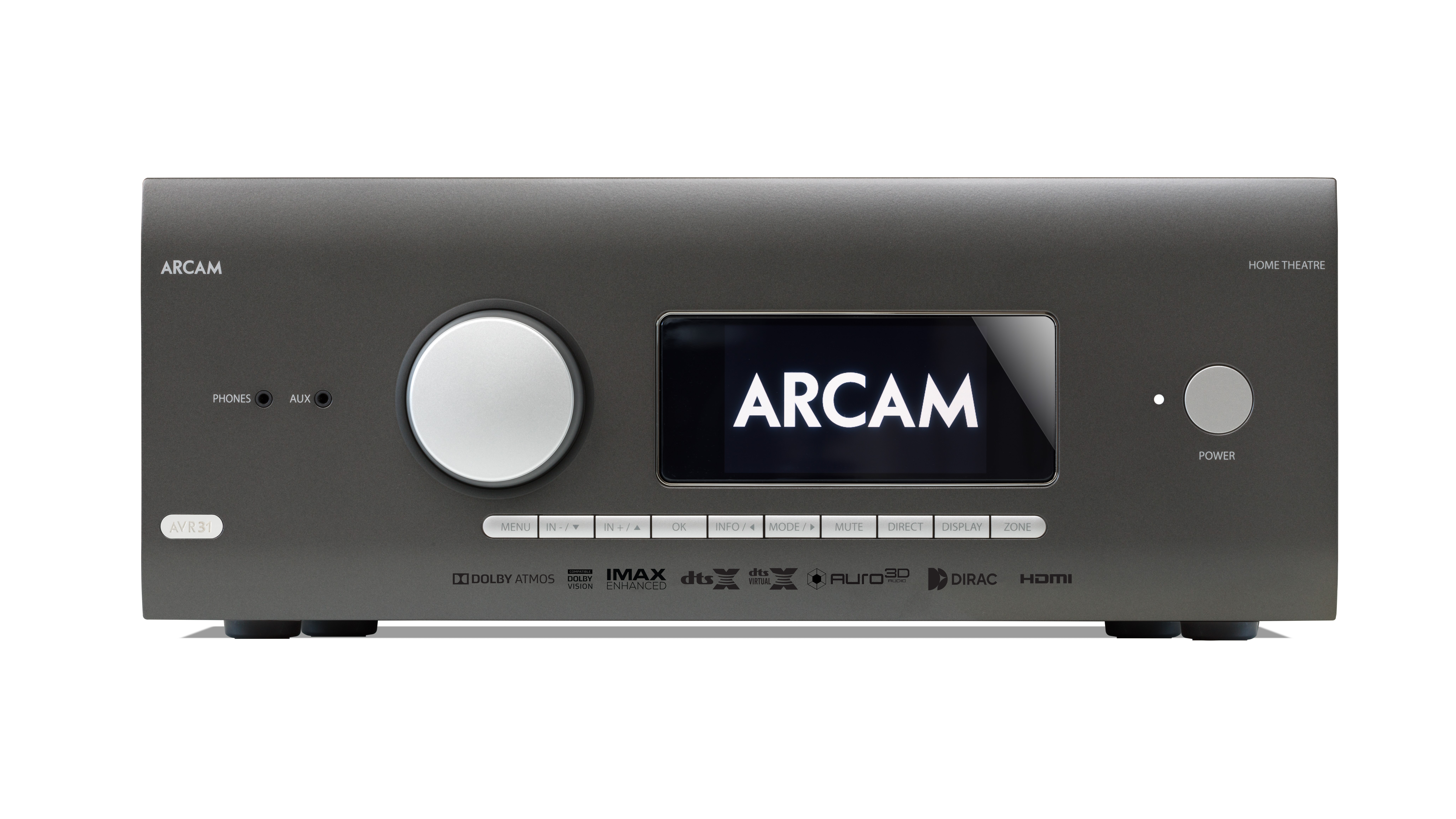
Arcam's revamped line-up of home cinema amplifiers was first released in 2020, bringing the sleek modern look of the British brand's HDA (High Definition Audio) products to its AVRs for the first time since Harman International bought the company.
Initially launching with just three models (the AVR10, AVR20, and the AVR30), Arcam has continued to maintain a small and focused AVR range aimed at audiophiles, that the company says puts sound and not features at its core. With prices a fair bit higher than those of its rivals, Arcam doesn't squander resources on padding out its spec sheet for the sake of it. While there are AVRs from other brands available that are certainly more impressive on paper, there is a consistency in engineering and approach across Arcam's range that is relatively unusual.
The company's latest offering is a four-strong range starting with last year's AVR5, a new 'entry-level' model. In early 2022 it was joined by the AVR11, AVR21 and AVR31, each of which supercedes a model from Acam's 2020 cohort.
While there are critical differences between each model that make them better suited to different systems, there are also many similarities. Although each model has a different power output, they all maintain the same number of amplifier outputs because seven channels are the maximum number that Arcam believes it can deliver without considerable compromise when compared to the performance of a stereo amplifier. In a similar vein, the entire range uses identical ESS9026 Pro DACs.
Since there is so much in common, we've done a round-up of Arcam's 2022 AV receiver line-up to help you choose the best product for you and your home cinema needs, so read on for an overview of all the essential features to look out for and a breakdown of the specs of each model.
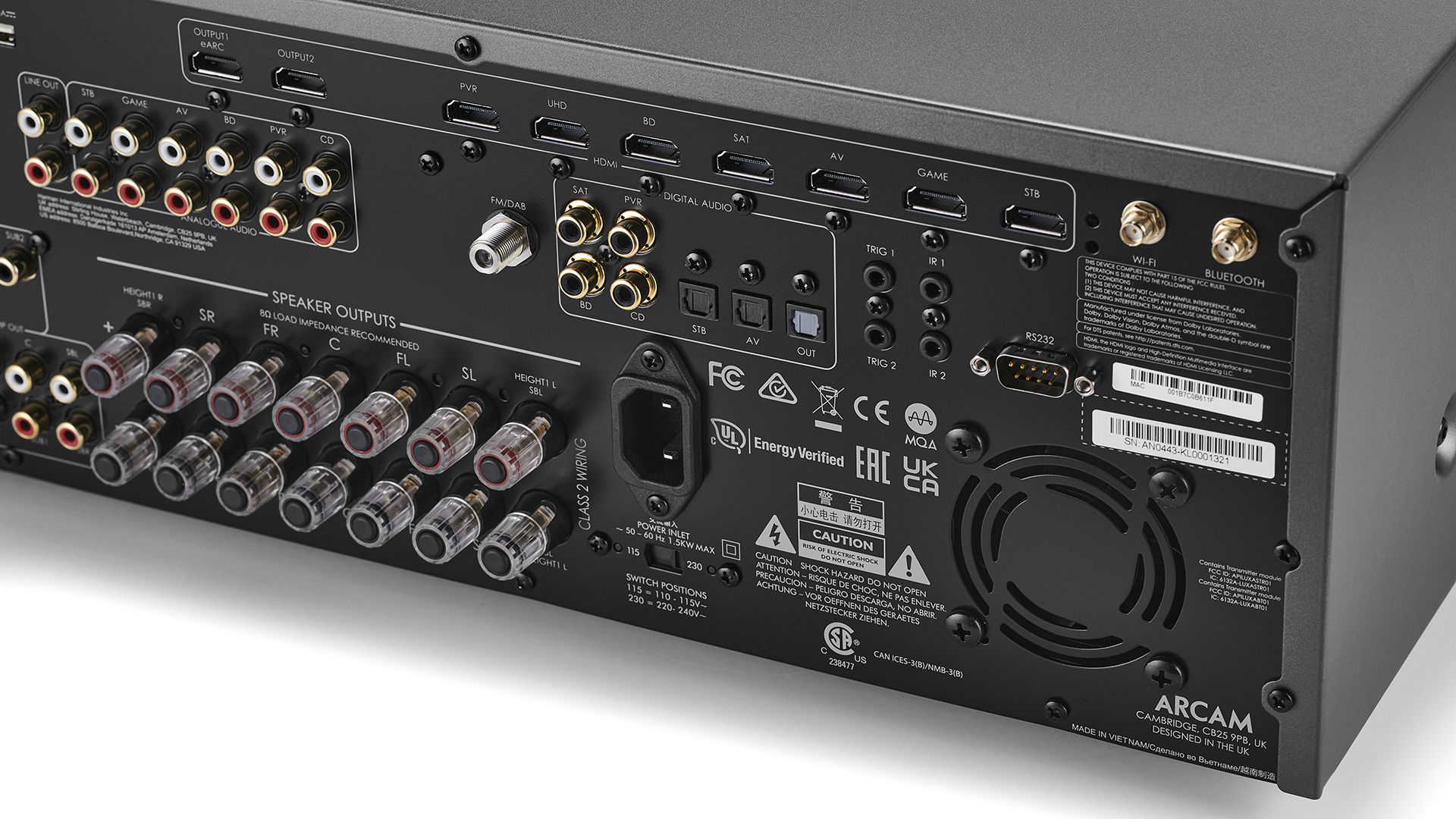
HDMI 2.1
The most notable upgrade that Arcam's 2022 AVRs have gained over their predecessors is HDMI 2.1 connectivity across the board with HDCP2.3. This means that the AVR31, AVR21 and AVR11 can handle 8K video signals at 60fps and 4K at 120fps. They also support enhanced gameplay features for those connecting a gaming PC, a PS5 or an Xbox Series X, such as VRR (Variable Refresh Rate) and ALLM (Auto Low Latency Mode).
However, unlike its slightly newer siblings, the AVR5 supports HDMI 2.0, with eARC being the only nod towards next-gen HDMI features. Arcam's reasoning for not including HDMI 2.1 as part of its core feature set is that it’s only currently relevant for hardcore gamers, and that’s not likely to change any time soon. Considering that no domestic movie source outputs signals beyond 4K at up to 60fps, which the AVR5 can easily deliver, most users will not find HDMI 2.0 wanting and will probably be happy not to pay for a feature they won’t be using.
As with Arcam’s 2020 AVRs, it is possible to retroactively upgrade the AVR5 to HDMI 2.1 by sending the unit to an authorised Arcam service centre and paying an unconfirmed additional cost. This is more of a commitment to users buying HDMI 2.0 models that their purchase will still be relevant and supported by the company five years down the line. We'd suggest that those who want HDMI 2.1 features right now should begin their purchase deliberations with the AVR11 instead.
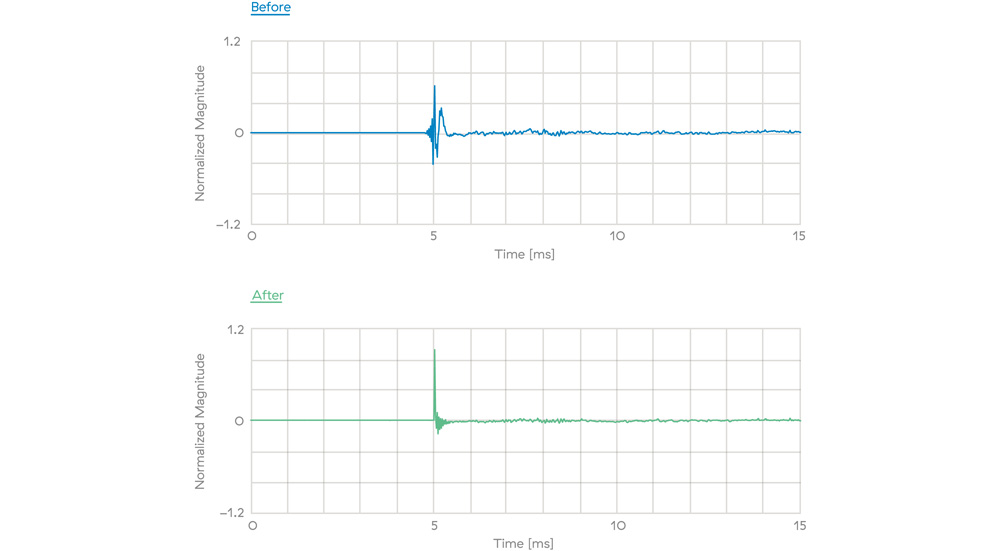
Dirac Live room correction software
Instead of using its own calibration system, Arcam instead offers support for Dirac Live’s advanced room correction software, which the company says delivers "a larger sweet spot, accurate staging, clarity and voice intelligibility" with its new models. While in previous years, all of Arcam’s AVRs featured Dirac Live Room Correction, only the top three models now include the software , licence (excluding Dirac Live Bass Control) and calibration microphone, while the AVR5 instead only provides upgradeable access at an additional cost.
Swedish audio software developer Dirac designs digital signal processing tools to help improve the sound performance of third party audio products in domestic spaces. While some other brands use equalisation software to flatten a room's frequency response, Dirac Live takes the approach of prioritising a speaker's impulse response alongside its balance in the room. If you like fine-tuning and getting into the minutiae of response curves, it's a great feature to have onboard.
However, Dirac isn't essential to set up your home cinema, and the AVR5's main menu does include an internal test tone and options to assign speaker distances, levels, filter slope and crossover points for manual calibration. The best way to perform this type of set-up is accessing the GUI via a phone or laptop on the same network by typing the AVR’s IP address into a web browser's address bar, while the Arcam Control app also offers remote access to the main menu.
If you do decide to upgrade to Dirac, its licence tiers start at £247 / $259 / AU$366 for limited bandwidth optimisation of frequencies from 20Hz to 500Hz; while full bandwidth calibration (up to 20kHz) or bass control for a single subwoofer each cost £333 / $349 / AU$491. Finally, an all-in-one package includes complete bandwidth control and a single subwoofer costs £620 / $649 / AU$919.
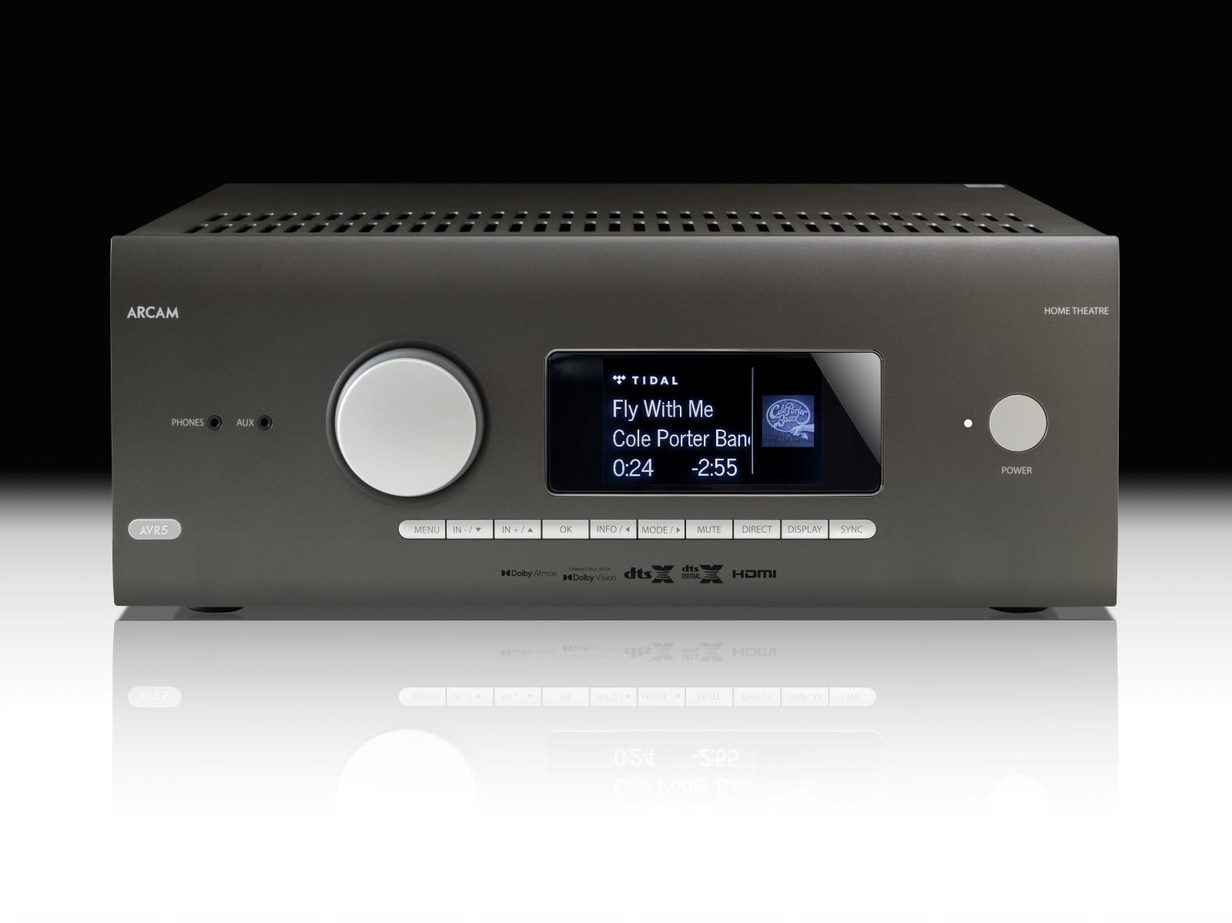
Class G Amplification
While all of Arcam's AVRs include seven channels of amplification, the type of circuit used varies depending on the model.
The flagship AVR31 uses the company's premium class-G amplifier circuits based on those found in its stereo amplifiers and features an over-engineered toroidal transformer to reduce noise. Class G is a proprietary label and is a variation of AB amplification that uses voltage rail switching, which Arcam says maximises the amplifier's efficiency.
Stepping down to the AVR21, AV11 and AVR5 and the amplifier type changes to a standard AB circuit, with decreasing output power levels, though the AVR21 retains a toroidal transformer while the latter two have frame transformers.
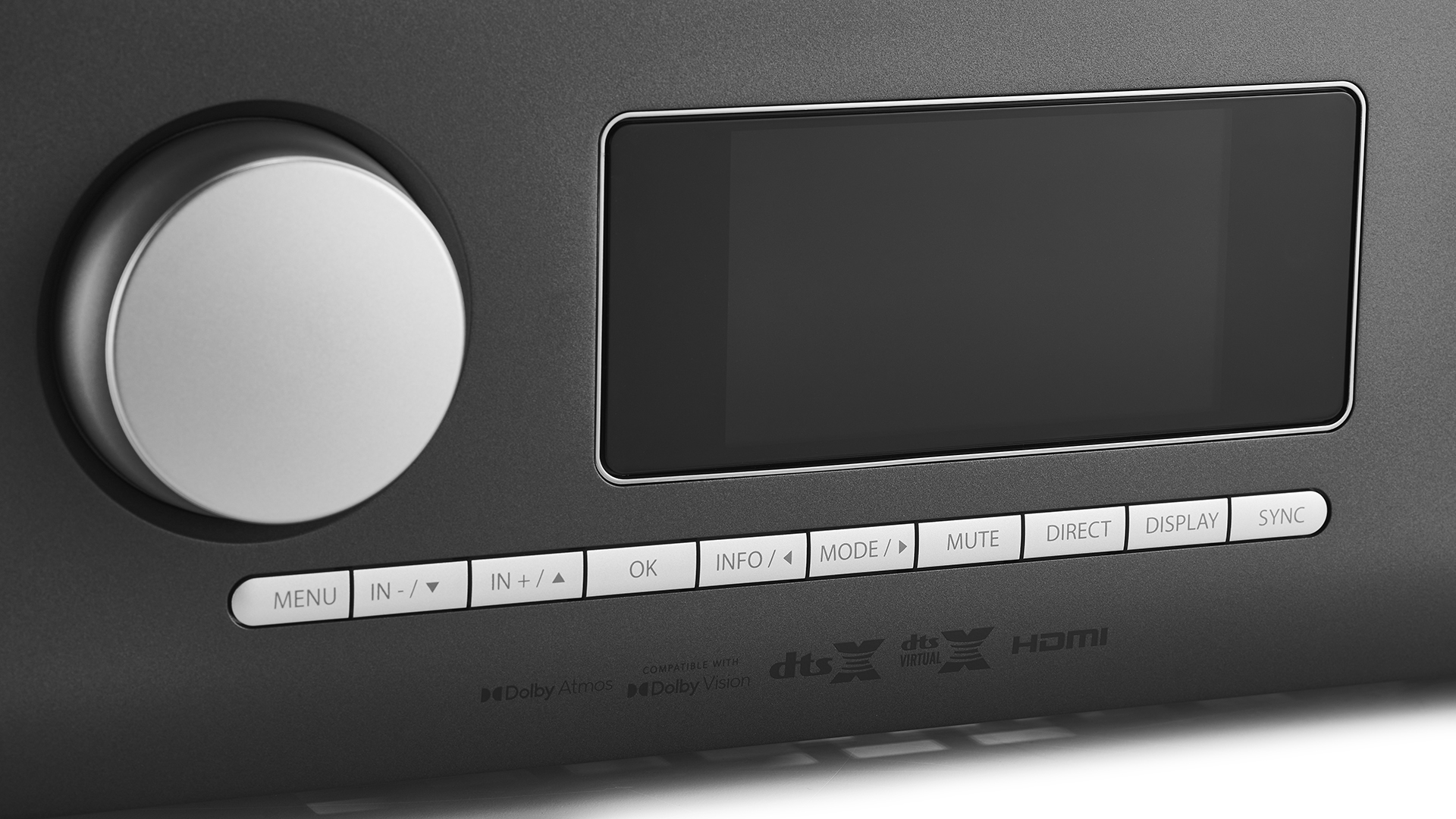
Range consistent SABRE DACs
As the models get more affordable within a product range, we tend to assume that the components used will be of lower quality. But for one crucial aspect of its internal workings, Arcam has remained consistent throughout all its AVRs. All four of its most recent home cinema amplifiers use ESS9026PRO DACs. Launched in 2016, this 32-bit, 8-channel DAC is designed for the "audiophile/enthusiast who demands the high quality and performance of a SABRE DAC at a more economical price point." The ESS9026PRO boasts a 124 dB dynamic range and -110 dB total harmonic distortion. In addition, it includes features intended to make it more flexible for engineers and reduce design-debugging time.
Arcam AVR 31 (2022)
RRP £5799 / $5250 / around AU$10,665
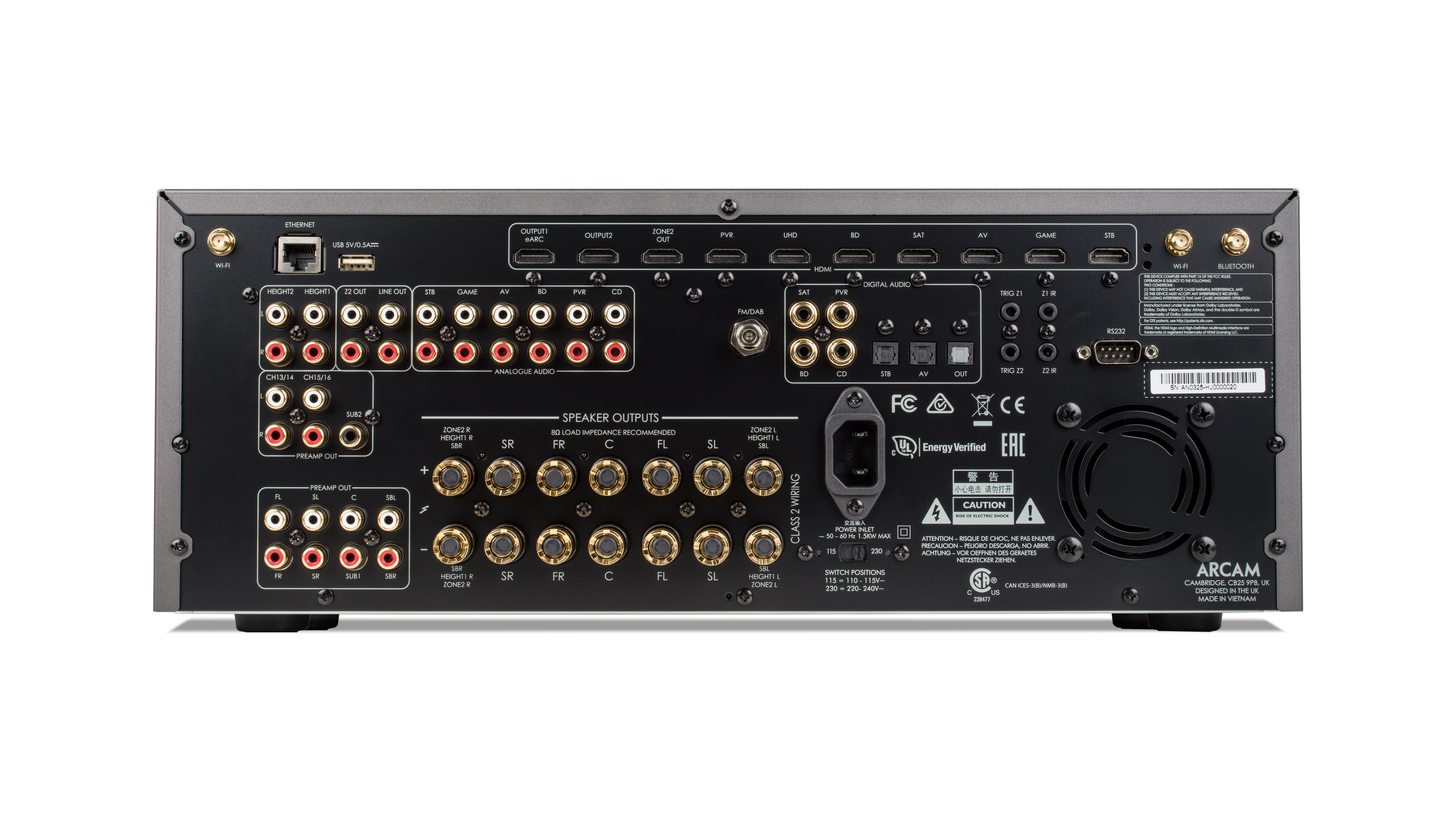
Arcam's flagship AVR, the AVR31, offers seven channels of class G amplification delivering 120 Watts per channel when two channels are driven with an 8 ohm load.
With up to 16 channels of decoding, it includes wide-ranging audio format support, including Dolby Atmos, DTS:X, IMAX Enhanced and Auro-3D. However, any system more extensive than 5.1.2 will require the use of a separate power amplifier. Arcam's own suggested options for this include the PA410 (£1399 / $1650 / AU$2995), which features four channels of AB amplification, and the two-channel PA240 (£2200 / $2750 / AU$3995) and seven-channel PA720 (£2900 / $3300 / AU$5995), both of which also use class-G amplifier circuits.
The AVR31 has a healthy seven HDMI 2.1 inputs and three outputs for ample connectivity, including Zone2 and eARC, with all its HDMI ports supporting 8K video signals at 60fps and 4K at 120fps with Dolby Vision and HDR10+. Users can also stream content using Apple AirPlay 2, Bluetooth aptX HD, Google Chromecast, Spotify Connect, Roon and Tidal Connect.
Room calibration is onboard courtesy of Dirac Live room correction, with an SPL microphone included in the box, while upgradable access to Dirac Live Bass Control starts at £333 / $349 / AU$491 for a single subwoofer.
- Decoding channels: 16
- Amplifier channels: 7 class G with a toroidal transformer
- Power output in stereo conditions: 120W (8 ohms, 20Hz - 20kHz)
- Zones: 2
- HDMI: 7-in / 3-out (eARC) with HDMI 2.1 with HDCP2.3
- HDMI Pass-through: All inputs support 8K@60fps and 4K@120fps
- HDMI eARC: Yes
- HDR: Dolby Vision, HDR10+, HDR10, HLG
- Gaming features: VRR, ALLM
- Sound Processing: Dolby Digital, DD+, Dolby TrueHD, Dolby Atmos, DTS, DTS-ES, DTS 96/24, DTS Express, DTS-HD HR Audio, DTS-HD Master Audio, DTS:X, Auro-3D, IMAX Enhanced, Dolby Surround, Dolby Virtual Height, DTS Neural:X, DTS Virtual:X
- DAC: Dual ESS 9026PRO with ESS reference voltage regulators
- Room Calibration: Includes Dirac Live, Dirac Live Bass Control requires an additional licence
- Streaming: Google Chromecast built-in, Apple Airplay2, Bluetooth aptX HD, Free MusicLife, supports MQA, Roon Ready, Tidal Connect, Spotify Connect
- Dimensions (hwd): 17 x 43 x 43cm
- Weight: 18.1kg
- Finishes: Silver
Arcam AVR 21 (2022)
RRP £3799 / $4700 / around AU$6987
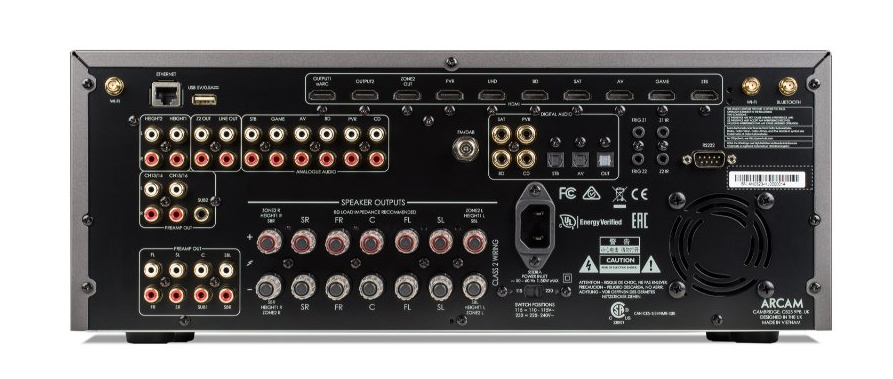
The AVR21 loses the class G amplification of the flagship model in favour of AB circuits and has a stepdown in power to 110 Watts per channel when two channels are driven with an 8 ohm load. However, it retains decoding for 16 channels of audio, Dirac Live room correction, the same ample format support and streaming options as the AVR21, as well as seven HDMI 2.1 inputs and three outputs.
- Decoding channels: 16
- Amplifier channels: 7 class A/B with a toroidal transformer
- Power output in stereo conditions: 110W (8 ohms, 20Hz - 20kHz)
- Zones: 2
- HDMI: 7-in / 3-out (eARC) with HDMI 2.1 with HDCP2.3
- HDMI Pass-through: All inputs support 8K@60fps and 4K@120fps
- HDMI eARC: Yes
- HDR: Dolby Vision, HDR10+, HDR10, HLG
- Gaming features: VRR, ALLM
- Sound Processing: Dolby Digital, DD+, Dolby TrueHD, Dolby Atmos, DTS, DTS-ES, DTS 96/24, DTS Express, DTS-HD HR Audio, DTS-HD Master Audio, DTS:X, Auro-3D, IMAX Enhanced, Dolby Surround, Dolby Virtual Height, DTS Neural:X, DTS Virtual:X
- DAC: Dual ESS 9026PRO with ESS reference voltage regulators
- Room Calibration: Includes Dirac Live, Dirac Live Bass Control requires an additional licence
- Streaming: Google Chromecast built-in, Apple Airplay2, Bluetooth aptX HD, Free MusicLife, supports MQA, Roon Ready, Tidal Connect, Spotify Connect
- Dimensions (hwd): 17 x 43 x 43cm
- Weight: 16.6kg
- Finishes: Silver
Arcam AVR11 (2022)
RRP £2799 / $3050 / around AU$5148
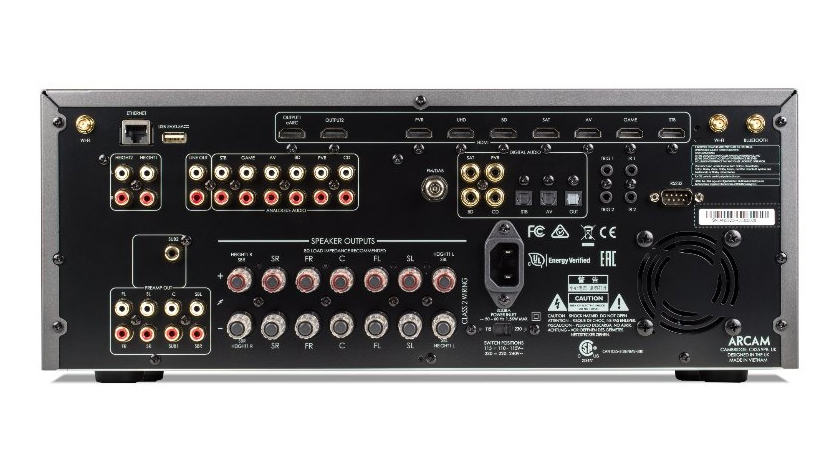
The AVR11 is the most affordable model in Arcam's line-up that includes HDMI 2.1 ports and Dirac Live room correction software.
It loses the toroidal transformer of the higher-end models, drops an HDMI output and Zone2 functionality and has decoding for 12 channels of audio rather than 16. Power-wise, the AVR11 can deliver 80W per channel when two channels are driven with an 8 ohm load.
- Decoding channels: 12
- Amplifier channels: 7 class A/B
- Power output in stereo conditions: 80W (8 ohms, 20Hz - 20kHz,)
- Zones: None
- HDMI: 7-in / 2-out (eARC) with HDMI 2.1 with HDCP2.3
- HDMI Pass-through: All inputs support 8K@60fps and 4K@120fps
- HDMI eARC: Yes
- HDR: Dolby Vision, HDR10+, HDR10, HLG
- Gaming features: VRR, ALLM
- Sound Processing: Dolby Digital, DD+, Dolby TrueHD, Dolby Atmos, DTS, DTS-ES, DTS 96/24, DTS Express, DTS-HD HR Audio, DTS-HD Master Audio, DTS:X, Auro-3D, IMAX Enhanced, Dolby Surround, Dolby Virtual Height, DTS Neural:X, DTS Virtual:X
- DAC: Dual ESS 9026PRO with ESS reference voltage regulators
- Room Calibration: Includes Dirac Live, Dirac Live Bass Control requires an additional licence
- Streaming: Google Chromecast built-in, Apple Airplay2, Bluetooth aptX HD, Free MusicLife, supports MQA, Roon Ready, Tidal Connect, Spotify Connect
- Dimensions (hwd): 17 x 43 x 43cm
- Weight: 16.5kg
- Finishes: Silver
Arcam AVR5 (2021)
RRP £2000 / $2000 / AU$3495
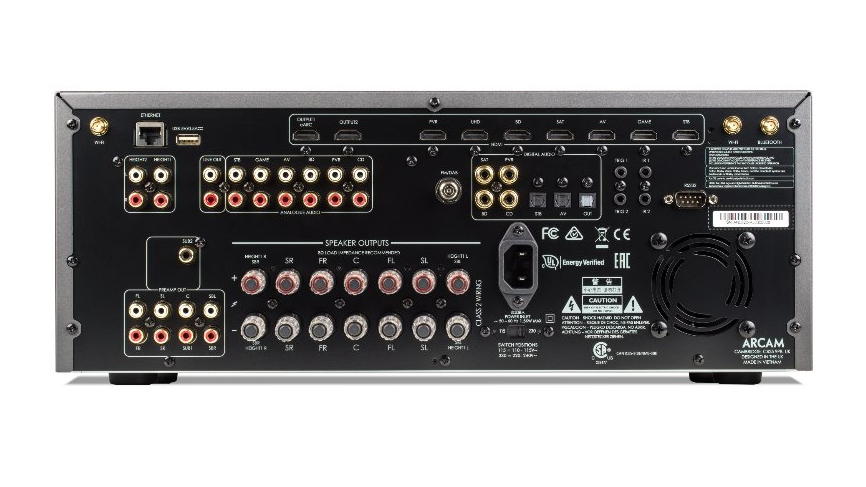
Arcam's AVR5 was released in 2021, and, unlike its newer siblings above, the HDMI ports on this entry-level model only support HDMI 2.0. This means that those connecting a gaming PC, a PS5 or an Xbox Series X console won’t be able to take advantage of features such as 4K@120Hz gameplay, VRR (Variable Refresh Rate) or ALLM (Auto Low Latency Mode). However, these features will only be of concern if you plan to use a next-gen gaming console as a source. If you intend to use the AVR5 mainly for movies, then HDMI2.0 will be more than sufficient.
The other significant distinction between the AVR5 and the rest of Arcam's line-up is that it is the only model that does not include Dirac Live Room Correction software. Instead, it provides upgradeable access at an additional cost to various licence types, which aren't terribly cheap.
Elsewhere the AVR11 maintains the same seven amplifier channels as the rest of the range, with a drop-down in power output from the AVR11 and loss of support for Auro 3D and Imax Enhanced.
Although it launched without the full complement of music streaming services that Arcam's more premium AVRs offer, support for Tidal Connect, Spotify Connect and Amazon Music HD has been added to the AVR5 retroactively via a firmware update.
Read our full review of the Arcam AVR5
- Decoding channels: 12
- Amplifier channels: 7 class A/B
- Power output in stereo conditions: 80W (8 ohms, 20Hz - 20kHz,)
- Zones: None
- HDMI: 7-in / 2-out (eARC) with HDMI 2.0
- HDMI eARC: Yes
- HDR: Dolby Vision, HDR10, HLG
- Sound Processing: Dolby Digital, DD+, Dolby TrueHD, Dolby Atmos, DTS, DTS-ES, DTS 96/24, DTS Express, DTS-HD HR Audio, DTS-HD Master Audio, DTS:X, Dolby Surround, Dolby Virtual Height, DTS Neural:X, DTS Virtual:X
- DAC: Dual ESS 9026PRO with ESS reference voltage regulators
- Room Calibration: Dirac ready, additional cost for a licence
- Streaming: Google Chromecast built-in, Apple Airplay2, Bluetooth aptX HD, Free MusicLife, supports MQA, Roon Ready, Tidal Connect, Spotify Connect
- Dimensions (hwd): 17 x 43 x 43cm
- Weight: 16.5kg
- Finishes: Silver
MORE
Yamaha's 2021 Aventage AVR line-up
Our pick of the best home cinema amplifiers and surround sound systems
Get the What Hi-Fi? Newsletter
The latest hi-fi, home cinema and tech news, reviews, buying advice and deals, direct to your inbox.
Mary is a staff writer at What Hi-Fi? and has over a decade of experience working as a sound engineer mixing live events, music and theatre. Her mixing credits include productions at The National Theatre and in the West End, as well as original musicals composed by Mark Knopfler, Tori Amos, Guy Chambers, Howard Goodall and Dan Gillespie Sells.
-
leemccann1 £600+ for dirac? Is it worth it? im not familiar with feature, is it just a 1 time function?Reply -
Sliced Bread Reply
I have Dirac on my receiver and it is a very capable room correction system, however to get the most out of it you need to be willing to spend *a lot* of time with it.leemccann1 said:£600+ for dirac? Is it worth it? im not familiar with feature, is it just a 1 time function?
Over about 6 months I created nearly 50 curves and multiple measurements. The result was improved integration between my speakers drivers (very impressive) and a very natural presentation.
At first I loved it but then I started to hear something was not right, which I confirmed with measurements. It seems Dirac never managed to correct the bass in my living room very well and kept adding a rather large null in the crossover region of the subwoofer, even though the room does not have a null there. I imagine that in my use case at least the software was not correctly resolving the phase of the subwoofer. This is weird because measured without Dirac there is no problem at all in this region. Dirac we’re not able to resolve the problem. Interestingly their more advanced bass management system made it worst.
For this reason I actually stopped using it.
Your mileage may vary and I can see that in the right circumstances it will do a wonderful job, but I would not personally buy it again. -
Sliced Bread Reply
Is that Dirac or the Arcam?Smokiro said:It really shines with Kef LS50 Meta.
I heard an Arcam AVR30 with Dirac off running a set of Kef R speakers in Sevenoaks and that was pretty darn good.
I didn’t get to spend much time with it for music which was a shame, but for movies it was wonderfully cinematic!
